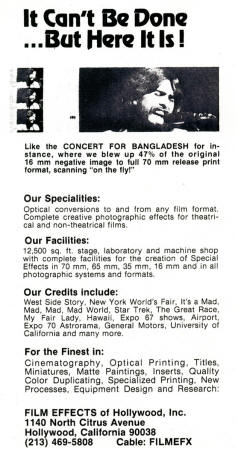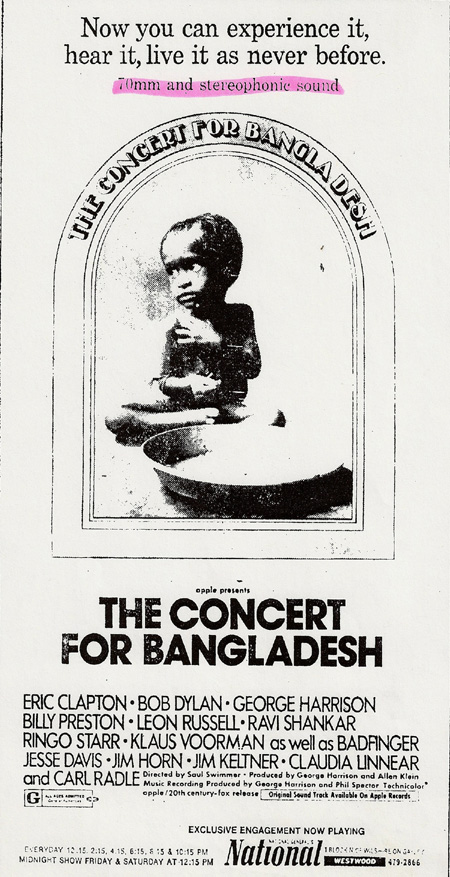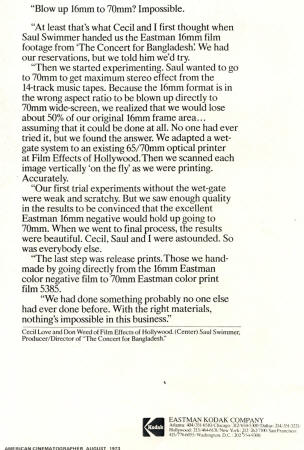It Can't Be Done...But Here It Is! |
Read more at in70mm.com The 70mm Newsletter |
| Written by: FILM EFFECTS of Hollywood, Inc (around 1973) | Date: 27.04.2012 |
 The
Advert from
FILM EFFECTS of Hollywood, Inc when they made
70mm print(s) of a 16mm film. Click on the advert to see an enlargement. The
Advert from
FILM EFFECTS of Hollywood, Inc when they made
70mm print(s) of a 16mm film. Click on the advert to see an enlargement.Like the CONCERT FOR BANGLADESH for instance, where we blew up 47% of the original 16mm negative image to full 70mm release print format, scanning "on the fly!" Our Specialities: Optical conversions to and from any film format. Complete creative photographic effects for theatrical and non-theatrical films. Our Facilities: 12,500 sq. ft. stage, laboratory and machine shop with complete facilities for the creation of Special Effects in 70mm, 65mm, 35mm, 16mm and in all photographic systems and formats. Our Credits include: West Side Story, New York World's Fair, It's a Mad, Mad, Mad, Mad World, Star Trek, The Great Race, My Fair Lady, Hawaii, Expo 67 shows, Airport, Expo 70 Astrorama, General Motors, University of California and many more. For the Finest in: Cinematography, Optical Printing, Titles, Miniatures, Matte Paintings, Inserts, Quality Color Duplicating, Specialized Printing, New Processes, Equipment Design and Research: FILM EFFECTS of Hollywood, Inc. 1140 North Citrus Avenue Hollywood, California 90038 (213) 469-5808 Cable: FILMEFX |
More in 70mm reading: “The Concert for Bangladesh”: The 70mm Engagements "A Place to Stand": Canadian 70mm Short Films 70mm Blow Up List 1972 |
 By
DON WEED, Film Effects of Hollywood By
DON WEED, Film Effects of HollywoodWhen Film Effects was first approached by producer Saul Swimmer, our reaction to his proposal to blow up 16mm to 70mm elicited our normal technical misgivings-which might be expected. However, on viewing the 16mm workprint, we decided to make preliminary tests. The subject matter, the stage lighting that supplanted usual photographic lighting, and the camera technique involved, seemed to us to be sufficient grounds for attempting what would seemingly be an impractical effort. For the tests, we first made a 65mm blow-up interpositive, using liquid-gate optical printing, of course. A contact 65mm internegative was made from this interpositive and 70mm prints from the internegative. The result was amazingly good-albeit more grainy than we would have preferred. The 70mm prints were sound-striped and six-track sound transferred at Todd-AO. The finished prints were shipped to Swimmer in New York, who screened them in regular 70mm theatrical houses … and the rest is history. 20th Century-Fox bought the release after seeing our 70mm test presentations. In the meantime, Film Effects made preliminary tests from Reversal Internegative direct to 70mm 5385 prints. The result was a marked decrease in the grain and a much improved overall quality. Since only a dozen or so 70mm release prints were required, it was decided to make them direct blow-ups from the 16mm CRI, with no other intermediate film steps involved. One of the interesting aspects of the project was the fact that, since we were blowing up the 16mm frame to fill the entire width of a 70mm frame, 53% of the original 16mm information was lost in the transfer to the 2.2:1 wide-screen format. Because the 16mm cameras utilized extreme closeups and zoom lenses, the remaining 47% of the 16mm had to be accurately scanned vertically during printing. To do this, a print from the 16mm CRI was first scanned on the printer and a proper footage log resulted in a scanning operation that could be repeated any number of times. Even those extreme close-ups where the 70mm framed only the central portion of a face were successfully scanned for the direct release prints, and the eyes, nose, and mouth then wound up on the blow-up instead of showing the top of the man’s head or his adams apple! As far as we know, this is the first time that a 16mm film has been blown up to 70mm for theatrical release and it's nice to know that it seems to be a to be a huge success, so far! |
|
 Kodak
advert for CONCERT FOR BANGLADESH film. Click to see enlargement Kodak
advert for CONCERT FOR BANGLADESH film. Click to see enlargementBlow up 16mm to 70mm? Impossible. At least that's what Cecil and I first thought when Saul Swimmer handed us the Eastman 16mm film footage from "The Concert for Bangladesh". We had our reservations, but we told him we'd try. Then we started experimenting. Saul wanted to go to 70mm to get maximum stereo effect from the 14-track music tapes. Because the 16mm format is in the wrong aspect ratio to be blown up directly to 70mm wide-screen, we realized that we would lose about 50% of our original 16mm frame area ... assuming that it could be done at all. No one had ever tried it, but we found the answer. We adapted a wet-gate system to an existing 65/70mm optical printer at Film Effects of Hollywood. Then we scanned each image vertically 'on the fly' as we were printing. Accurately. Our first trial experiments without the wet-gate were weak and scratchy. But we saw enough quality in the results to be convinced that the excellent Eastman 16mm negative would hold up going to 70mm. When we went to final process, the results were beautiful. Cecil, Saul and I were astounded. So was everybody else. The last step was release prints. Those we hand-made by going directly from the 16mm Eastman color negative film to 70mm Eastman color print film 5385. We had done something probably no one else had ever done before. With the right materials, nothing's impossible in this business. |
|
Comments | |
 Nice
end title as seen on YouTube Nice
end title as seen on YouTube29.04.2012 Dear Thomas, This isn't a very useful contribution but I saw "THE CONCERT FOR BANGLADESH" on it's original West End showing in 70mm. The picture quality was what you'd expect from 16mm of the time (pre Super 16 which is much better) but it was terrific because the sound made for a concert experience. The cinema, The Rialto, wasn't very big and has long since been converted into a restaurant and then shops. Best wishes, Malcolm Blackmoor, UK |
|
 "The
Concert of Bangladesh" was shown in 35mm at the Hamburg Esplanade
Filmtheater, there is no hint "70mm" in it. German advert from Gerhard
Witte's collection "The
Concert of Bangladesh" was shown in 35mm at the Hamburg Esplanade
Filmtheater, there is no hint "70mm" in it. German advert from Gerhard
Witte's collection11.05.2012 Hi Thomas, My Father was Chief Projectionst at the Rialto Cinema in Coventry Street. He screened the film in 35mm 4-track magnetic stereo (I did see it). I once heard that a 70mm 6-Track print screened for 3 day's at the Casino Cinema in Old Compton Street, it was taken off due to many complaints re the picture quality. Best Regards, Roger Young, UK 14.06.2012 Dear Thomas, I've only just seen that a reply has been posted contradicting my thought that I saw this in 70mm at The Rialto. The answer has to be correct but what convinced me was that there was a 70mm print credit on the end. This misleading shot was obviously also on the 35mm version. Sorry to post wrong information. Best wishes, Malcolm Blackmoor, UK 23.06.2012 I ran "Concert For Bangladesh" in 35mm optical and 70mm. The 70 mm were a little grainy, to be expected with lighting levels. The surround circuit was used mostly for applause. Owing to the 70mm optics, I liked the 70mm image...I was able to run the same reel on 2 machines in 70mm on #1 and 35mm on #2....this was for my own study. The sound was excellent. John Carver, USA |
|
| Go: back - top - back issues - news index Updated 21-01-24 |
